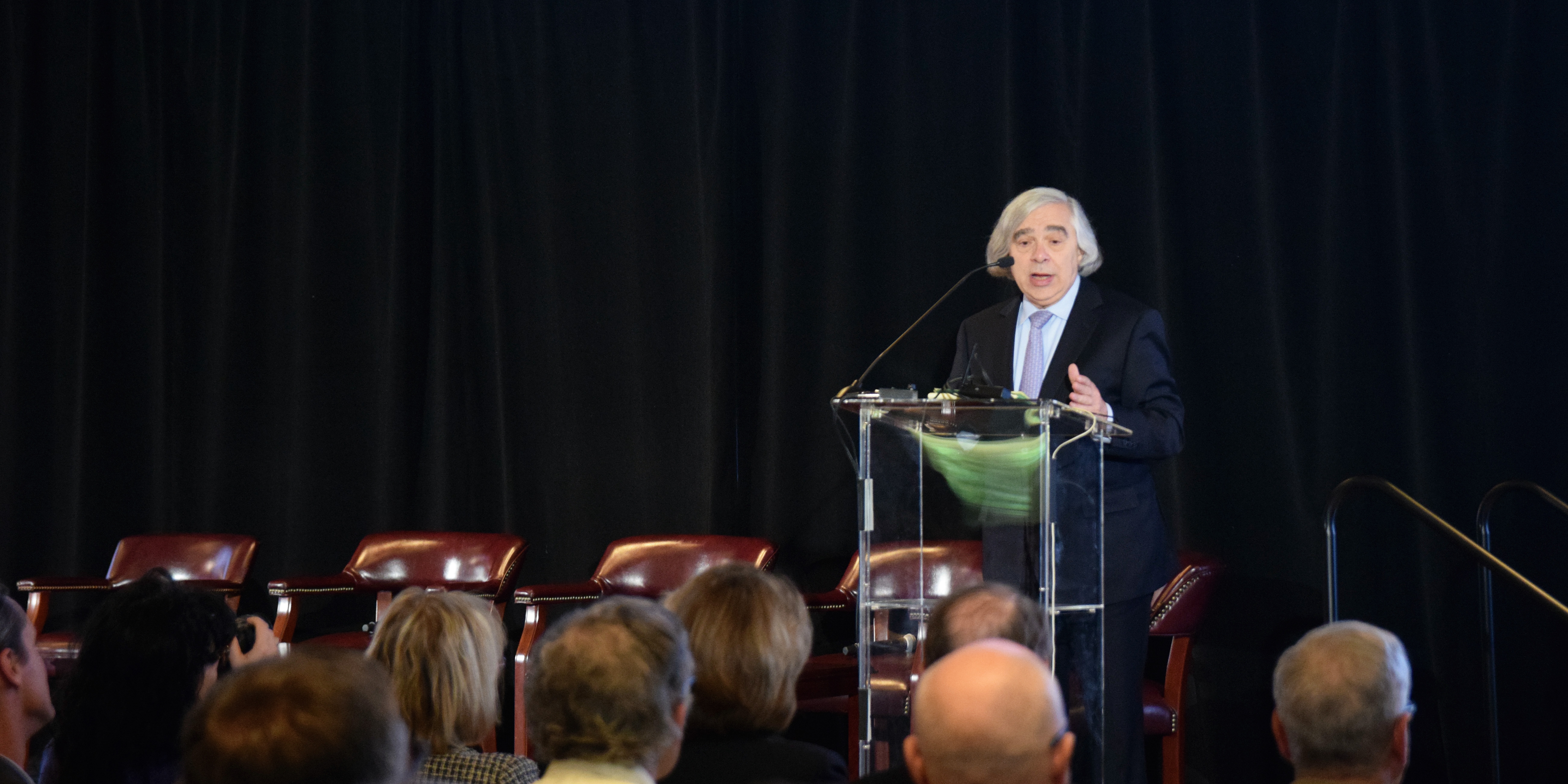As California strives to hit its 50 percent renewable energy goal by 2030 and a net-zero emissions economy by 2050, former U.S. secretary of energy Dr. Ernest Moniz Ph.D. ’72 shared with the Stanford community the details of a report on how trends in green energy development and energy markets might enable California to reach these ambitions.
“For the students in the audience, it’s easy to get discouraged by the sort of willful ignorance that is coming from Washington [D.C.] these days,” said moderator Mark Zoback, geophysics professor and the director of the Natural Gas Initiative at Stanford. “But California is not alone in this … [and] many of us are engaged in trying to help the developing world develop their economies in the greenest possible way.”
The Wednesday evening talk in Tresidder’s Oak Lounge centered on the state’s Senate Bill 100 (SB 100) legislation, which outlines the new energy requirements for greenhouse gas emissions. Moniz, a Massachusetts Institute of Technology (MIT) nuclear physicist and president of the energy think tank Energy Futures Institute (EFI), joined his EFI colleague Melanie Kenderdine in summarizing the findings of their report, “Pathways for Deep Decarbonization in California.”
The presentation was followed by a panel of experts from academia, industry and activism including Senior Manager at ConEdison Lisa Briggs, co-director of the Stanford Precourt Institute of Energy Sally Benson and Clean Air Task Force co-founder Armond Cohen.
Moniz opened his talk by amiably ribbing the Stanford Precourt Institute of Energy, an academic rival of his own MIT Energy Initiative. However, as a Stanford alum and an experienced public servant with ties to Palo Alto residents and Hoover fellows, he made it clear that he likes California, especially the aggressive goals set by SB 100.
The summary of the clean energy report, released online before the talk, affirmed that California “can indeed meet its aggressive 2030 and mid-century targets, [but] doing so will require success across multiple sectors of the economy, with multiple technologies contributing in each.”
The report was structured as a collection of 31 technology pathways, using a bottom-up market analysis for each sector to determine which technologies and changes might lead to carbon reductions.
“Our conclusion is that with a lot of hard work, pulling together different stakeholders and working across all the sectors in the energy economy, success can be achieved,” Moniz said.
Some of the technology pathways are expected and familiar. For example, both Moniz and Kenderdine sang the praises of the rapidly decreasing costs of solar power and electric cars.
But many technologies that Moniz offered as potential boons to the California energy economy were unexpected — Moniz emphasized that although the 2030 goals are attainable with judicious use of current technology, the 2050 goals require speculative technology only now in early stages of development.
For example, he said that a net-zero emissions economy would probably require carbon capture technologies, huge advances in energy storage and a more efficient energy grid. Renewables currently have many shortcomings, such as the fact that wind and solar both produce far more power during the daytime and summer. Technologies to mitigate these problems would reap massive dividends.
Despite the challenges of cost, Moniz said that the report spells out the necessary “innovation portfolio for breakthrough ideas [that are] particularly suited to California’s challenges [to ensure] that there is as much optionality and flexibility to meet the stringent mid-century goals of 2050.”
Although he worked in the Obama administration, Moniz voiced support for natural gas and nuclear power — energy sources Republicans traditionally favor and which many environmentalists hesitate to support.
Moniz argued that no renewable fuel can truly compete with natural gas at the moment, so it would be impossible to demand that industry electrify completely.
He added that by replacing coal and other dirtier fossil fuels, natural gas has been responsible for most of the United States’ progress toward its national climate goals. Technologies such as carbon capture and storage (CCS) and steam methane reforming (SMR) make natural gas a promising candidate for generating hydrogen fuel and sequestering carbon from the atmosphere as well, he said.
Benson agreed that CCS and SMR are uniquely good for California given the state’s sequestration-friendly geology and gas infrastructure. Natural gas may also play a role in keeping America safe from cyber attacks and reducing reliance on rare earth metals — used to make renewable energy technology — from abroad.
Yet, while Moniz noted that while natural gas could be a bridge to moving toward an electricity- and hydrogen-driven economy, it is still not a zero-carbon option. In light of this, Moniz said that negative carbon technologies are not being pursued as strongly enough as they should be. The necessary technologies will come with cost and scalability challenges similar to those we currently struggle with; “that’s the innovation agenda we have to pursue.”
Moniz also argued that nuclear power, as politically contentious as it may be in California, offers a practical way to generate emissions-free electricity. Realistic technologies such as smaller plants and plant-building techniques borrowed from France and South Korea may improve public perception of safety and lower prices significantly.
Cohen agreed with Moniz’s stance on nuclear power, arguing that political dogma ought not to interfere with open-minded consideration of all realistic options. However, Moniz acknowledged that barriers such as a moratorium on new reactors in California, given the lack of a waste repository, make nuclear a hard sell.
“2030 [goals] mean we’re using today’s technology more intelligently, building the infrastructure and figuring out how to get going with what we have,” Zoback said. “But for a university community, I think the 2050 goals — which are even more ambitious — really opened the door […] for students at [universities] to fully engage with these technologies.”
Contact Cooper Veit at cveit ‘at’ stanford.edu.
